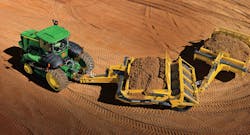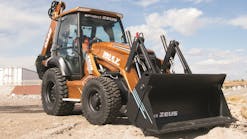“If you fail to plan, you are planning to fail” is a quote credited to Benjamin Franklin. Perhaps nowhere is this more critical than a construction site, with its various inherent components needed to ensure success from compact equipment, to generators, lighting, signage, and pumps.
Typically, a project begins with a thorough site assessment, points out Andy Kosko, District Manager at United Rentals, Washington DC. “During this process, every task that’s needed to complete the project is identified, scheduled, and assigned to the responsible party,” he says. “This is also the phase when equipment requirements are specified and any ancillary needs, such as operator training, are planned. If the project requires engineered solutions such as trench safety, an engineer may be involved in the assessment.”
A Thunder Creek MTT460 service trailer on the work site
A contractor begins planning for the work site by considering the scope of the project and in which phase the contractor is involved, points out Juan Quiros, Director of Product Management for Multiquip. “Understand the project scope and your role, and be able to balance new work with existing workload of concurrent projects,” he says. “Ask yourself: Do I have the labor force and equipment necessary to handle the job? What equipment do I have ready to use in my fleet? Is there any equipment in my fleet that needs repairs? What is the level of repair required, and is there sufficient time to complete it? What additional equipment will I need to buy or rent?”
Jim Olson, Product and Safety Engineer for Terex Utilities, says, “understanding the big picture of how the task, locale, equipment, and people must interact safely and efficiently on the work site is one of the biggest challenges on any utility project because there are multiple variables that crews must assess and manage.”
Before any work commences, a site survey is necessary to identify potential hazards that need to be avoided during operation, including ditches, drop-offs, holes, debris, sewers, overhead obstructions, electrical conductors, and underground utilities. “Because a lot of new installation work is in sensitive environments, we recommend sending right-of-way agents and surveyors out to the project site prior to job startup to determine if any special permits from the Department of Natural Resources or wildlife organizations are needed to work in the area,” points out Olson. “Also, it is important to work with these groups to ensure site setup is safe for the crew and equipment, as well as for the environment.”
Determining power needs is an extremely important early step in work site planning, points out Dave Streiff, Director of National Sales for Generac Mobile Products. “A job site simply can’t function without power,” he adds. “Most often, the office job trailer is onsite prior to having site power, so a mobile generator is required. In addition, appropriatelighting and heating are early considerations to ensure the site is safe and comfortable when subcontractors arrive on the job.”
In order to start planning, the contractor should be prepared to furnish detailed information on the scope of work; any known constraints such as noise restrictions or adjacent structures; and the availability or need for safety gear, training, consumables, tools, equipment, and labor, says Kosko. “Additionally, the contractor should furnish an expected timeline for the various project phases and a target completion date,” he adds.
Contractors should look at the equipment they need and what is powering them, notes Gus Armbruster, Atlas Copco Product Manager, Handheld Construction Tools. “Do they have pneumatic tools? If so, do they have the right size and number of air compressors available on the job site? Answering these questions is always a good start to planning and bringing the right equipment to the job site,” he says.
Successful planning will take into account safety for the public and the crew, notes Tim Hoffman, Atlas Copco Product Manager, Rollers. “Contractors need to be aware of each job site’s regulations and restrictions,” he says. “Populated urban areas might have noise or vibration restrictions. Contractors might also need to meet certain emission regulations or environmental standards. These factors impact when progress on the project can take place and the type of equipment contractors can use.”
For example, to meet emission standards, a contractor might need to use Tier 4 Final engines, says Hoffman. “If they are working in noise-restricted areas, such as near hospitals or residential communities, using equipment that generates few vibrations and low decibels allows contractors to meet those requirements,” he adds.
Atlas Copco has designed machines that take into account noise decibels that could impact the operator and public, says Hoffman, adding that such machines especially are an asset during nighttime construction.
Contractors also need to consider maintenance and the servicing schedule of the equipment onsite, he says. “Finding equipment that is easy to operate and maintain significantly impacts the project’s schedule and budget,” he points out. “When something breaks down, what will the plan be? Will the equipment need to be transported to a mechanic or is it easy enough to service onsite? If it stays onsite, how will traffic be directed around the equipment that needs maintenance, and will it slow the project flow? Planning for this ahead of time will save contractors headaches.”
Telematics such as Atlas Copco’s Dyn@Link system are another way to reduce the hassle of equipment maintenance and management, says Hoffman. The system is designed to help contractors know where their equipment is, as well as when and what kind of servicing the equipment needs.
When choosing light compaction equipment, contractors should know the type and composition of ground materials on the job site and the size of the job site, says Darrell Engle, Atlas Copco Product Manager, Light Compaction and Concrete. “Knowing the size of the job site and what they’re working with will determine the correct equipment to use,” he adds. “For example, a contractor might use ride-on rollers to compact all onsite areas, or they might need a reversible plate or forward plate compactor for narrow workspaces.”
It is important to properly size the required equipment for the job, Streiff points out. “Failure to do so may result in less-than-ideal performance, and potentially increase maintenance and rental costs,” he says. “With regards to generators, current engine tier technology requires an adequate load to optimize the generator’s performance. Oversizing the generator may sound like an appropriate insurance policy; however, this may result in less reliable performance and the contractor may pay more for a larger machine when a smaller kilowatt would suffice.”
A contractor needs to determine if the ground is firm enough to support equipment, says Olson. “With Terex utility bucket trucks, for example, if the ground is not firm enough, you need to use pads under the outriggers and crib as needed to distribute the load or reposition the truck on firm ground,” he says. “If your bucket truck does not have outriggers, or is only equipped with one set, make sure all the tires and axle suspension springs are equally loaded.”
Equipment should always be set up in a position to safely do the work. “Because of the environments you’re working in, you may need to put down special matting to park trucks on,” says Olson. “You may also need to create a road or special access points in and out of the site for your trucks to travel on, as well as put up fencing or other barricades to make sure you protect site conditions.”
It is also important to evaluate the site’s ambient conditions, including temperature, says Olson. “Operating in extreme weather conditions requires that you take extra precautions to protect your crew and truck,” he adds. “A job briefing session is a good way to keep crews informed of the conditions of the job site and expectations for the project. These sessions not only include information such as identification of potential hazards discovered during the site survey, but also a discussion about what is required by the truck and the crew to avoid these potential hazards. Every member of your onsite crew should know the location, function, and operation of all the controls, including emergency and accessory operation.”
If a job is in an area with pre-existing infrastructure, the discussions can focus on the location of equipment setup, traffic patterns, street closures, and potential obstacles or hazards, including energized power lines, says Olson.
Once crews are onsite, the senior person on the team will make final decisions based on site conditions, he adds.
Contractors should work with rental location managers or manufacturers to determine their custom power needs, says Streiff. “Generally, providing the voltage phase, operating voltage, and the total amps will allow for proper generator sizing,” he adds. “Additional considerations incorporate motor starting requirements and the type of items being powered—an example being sensitive electronic equipment.”
Construction sites require a variety of equipment to help ensure the site maintains uptime and safety requirements, including generators, light towers, pumps, heaters, and water trailers, notes Streiff.
“Each of these items provide benefits that are crucial to maximizing profitability through optimizing uptime,” he says. “Without this equipment, sites run the risk of missed deadlines and unsafe working conditions. Site managers typically start with local rental locations for their equipment needs and can always contact the manufacturer directly for additional items.”
Deriving more time and fuel efficiencies is a priority for job site preparation. Thunder Creek Equipment provides fuel and service trailers, specialty service trailers, and diesel exhaust fluid (DEF) trailers for bulk diesel storage and distribution and mobile field maintenance. One of the most recent introductions to the market is Thunder Creek Equipment’s multi-tank trailer, which comes in configurations of four, six, or eight independent diesel tanks of 115 gallons or fewer.
“Because they are 115 gallons or less, they do not qualify as bulk containers, which means that depending on the size of the trucks hauling it, construction contractors and land development contractors can now haul bulk diesel on their own without requiring a commercial driver’s license or a HAZMAT endorsement,” notes Luke Van Wyk, general manager of Thunder Creek Equipment.
Among the advantages of doing is contractors being able to control their own fueling schedules and access to fuel, he adds. “They can oftentimes haul that bulk trailer to the site with vehicles that are already going to that site instead of having to contract with a third party fuel distributor or another method of getting that fuel to the construction site.”
More pieces of heavy equipment are going to Tier 4 solutions with Selective Catalytic Reduction (SCR) technology, he says, adding those machines require diesel exhaust fluid.
Thunder Creek offers a trailer option with a two-in-one pumping system capable of pumping diesel exhaust fluid into the tank and then out of the tank and into the machine. “It is a completely closed system in that it does this in a way that ensures the diesel exhaust fluid from the point it is distributed into the tank is never exposed to environmental contaminants such as dirt, fluid, liquid, oils and other contaminants that exists on job sites,” says Van Wyk. “That’s very important to the health and performance of the machine because diesel exhaust fluid, once contaminated, can have a long-term impact on the health of that SER system.”
The typical site prep or land development contractor is running a host of equipment, including bulldozers and excavators, wheel loaders, skid steers, and compact track loaders, which require diesel exhaust fluid, notes Van Wyk.
Thunder Creek has designed a single trailer into an all-in-one field maintenance and service tool to help contractors streamline how they perform everything from the daily diesel fill-up to diesel exhaust fluid storage and handling. An optional utility box includes additional tool storage for such items as a welder, generator, and air compressor with an integrated work bench on the back to make it a fully self-contained work station with bulk diesel and a diesel exhaust fluid distribution system.
Another option is an LED light tower outfitted onto the trailer. “Looking at your envelope of when it makes sense to get maintenance done and service completed, you don’t want to do that during the course of the working day, so much of this ends up getting put off until the end of the shift or pre-shift,” notes Van Wyk. “The light tower extends the envelope of when they can use that trailer. They can see onsite and take advantage of after-hours work.”
Some of the most important elements on a job site meet the significant and serious challenge of being exposed to traffic, notes Olson. “Traffic control efforts include signs before and after the work area to catch the attention of drivers you’re sharing the road with,” he adds. “If you do not already own this type of equipment, rental is the best way to get it quickly.”
Depending on the site, a contractor will more than likely need lighting for security and worker safety in the early morning hours or late in the day, notes Kosko. “Other ongoing needs include temporary electrical power in the form of generators, and usually some type of pump over the course of the project,” he adds. “These items are most often rented to ensure the safest, most modern, and best fit option for the idiosyncrasies of each project.”
Site communication is extremely important and takes several forms, says Kosko. “Two-way radios are still a staple, although the proliferation of cellular phones is changing this. Radios can be rented or purchased outright.
“Signage is another staple of communication. Signs are required onsite to direct flow, identify hazards, communicate safety policies, and designate various work areas. Signage falls into two categories: standard signs that comply with regulations and are sold by providers such as United Rentals, and custom signs that are site-specific and need to be produced by a local sign company.”
Some job sites require equipment that can compact soil in cramped or narrow work sites, such as in trenches, around foundations, for landscaping, and even roadwork, Engle points out. “Forward plate compactors work well for compacting soils for installation of hardscaping and concrete,” he says. “For compaction in the narrowest of areas, including, ditches, foundations, and trenches, a rammer is an optimal choice.”
Depending on the scope of the project, some of the equipment needed may come from existing fleet, says Quiros. “If additional items are needed, it may make sense to rent versus buy,” he says. “Buying equipment may require substantial capital investment and additional considerations including insurance, maintenance, and storage, among other factors. Rental provides equipment flexibility, reduced insurance worries and concerns about maintenance.”
Brian Wade, Vice President, Clarke Power Generation, says power generation on a construction site is most effective when sized correctly based upon site needs. The company has a calculator on its website.
Wade points out that rental companies also are knowledgeable in that regard, but contractors should take care in seeking out someone who knows the equipment well because “most rentals are oversized, so it really makes a lot of sense so you don’t pay for more than you need.”
Contractors should consider the generator’s capacities and how much run time is needed. “Most mobile generators have fuel tanks that give them a minimum of 24 hours of run time on a full tank at full load,” says Wade. “If you’re half-loading it or three-quarters loading it, you’re going to get more than 24 hours on a tank, and you may not want to pay to have the fuel truck come out once a day.”
Wade points out that most construction site lighting comes with its own power source and miniature generators to produce enough power to run a saw or charge radios. Most rental places can provide a range of equipment, including lights, power generation, and air tools.
In renting the equipment, tasks such as maintenance are included in the rental fee, Wade says, adding that oil changes are done at intervals, typically every 500 hours.
The company is working on a natural gas power generator and recently launched a mobile unit to offer 24 hours of run time on a propane tank integrated into the unit.
Standing water is often a problem on new construction sites or in trenching and shoring applications where soil has been excavated, points out Joe Moser, Atlas Copco Product Manager, Pumps. “Having submersible dewatering pumps onsite and ready to go will save time and money,” he says. “Pumps remove groundwater quickly to maintain the integrity of the excavated site and minimize the risk of water loosening the soil in a trench, causing it to collapse.”
Look for a pump built with durable materials and with mechanisms that stop the unit if it overheats or an electric current overloads the pump, says Moser. “This protects the motor from damage and extends the life of the pump.”
Contractors can benefit from renting or buying a pump, says Moser, adding that they can usually determine the right choice based on budget and by how often and how long they will use the pump.
Hoffman notes that versatile equipment allows contractors to use one piece of equipment for multiple applications. “This is not only cost effective, but also enhances productivity, especially when heavy compaction equipment is needed,” he says. “One piece contractors often choose is our CA1400 soil roller. The unit can compact a wide range of materials and lets operators adjust the settings and change the amplitude to suit different lift thicknesses.”
Maintenance of equipment and the areas in which contractors work throughout the duration of the project is critical.
Proper equipment maintenance is vital to keeping the job site powered, notes Streiff. “If there’s any downtime at all, you risk falling behind schedule and going over budget,” he adds. “Maintaining a product’s engine is the first step toward continual uptime on the work site. A poorly maintained engine slows down an operation and reduces profitability. It also brings unneeded safety risks to the job.”
Each work area needs to be maintained free of trash, debris, and scrap material for safety reasons, and frequently site roads, parking and staging areas, and entrances need to be maintained, Kosko points out.
“This can involve the regular removal of mud and dirt, and sometimes the grading of uneven surfaces,” he says. “From time to time, temporary cooling and heating may be required onsite. These temporary needs are most effectively solved with rented equipment because the contractor can stop the clock on costs when the equipment isn’t needed.”
Olson points out that before each workday, the crew needs to conduct a visual inspection of the equipment being used onsite—oil, tires, suspension, torsion bars, outriggers, safety equipment—for any leaks, loose items, cracks, or damage before work begin.
“When multiple operators use the same equipment, no one operator can assume that he or she knows exactly the condition it was left in by the previous user, which further emphasizes the need for pre-flight visual inspection and cycling,” he says.
Once work begins, contractors should follow established protocol for traffic control by setting up road cones or barricades and signs to divert traffic away from the work area. It is the crews’ responsibility to know and implement proper setup procedures once site conditions have been assessed, says Olson.
It is also important to always clear the area of bystanders and miscellaneous obstacles and job site debris, including downed power lines and fallen tree limbs, he adds. “Remember, tree limbs can become energized when touching a live power line. At the end of the workday, once you are back to the shop, inspect, maintain, clean, and repair your equipment according to manufacturer’s guidelines. Keep up with preventive maintenance inspections as required by the manufacturer,” he says.
Routine engine maintenance helps keep power products operating safely and properly over the life of the project. “Many products come with a basic engine maintenance schedule courtesy of the engine manufacturer,” says Streiff. “Each day on the work site should start with a visual walkaround inspection of the equipment prior to starting the engine. These daily inspections are critical as serious damage may occur to the prime mover if left unchecked.”
In addition to daily inspections, there are numerous other items that should be checked at regular intervals, he adds. “These intervals can range from inspecting every 100 hours of operation to every 3,000 hours or more,” says Streiff. “Many items in the engines should be serviced every 250 to 500 hours, or 12 months, whichever comes first. One of the more important steps at this stage is changing the engine oil and replacing the oil filter. Temperatures dictate appropriate oil viscosity and cold weather can have a more dramatic effect on the condition of the oil filter.”
Continuous training in the safe operation of construction equipment and regulatory compliance should be top priorities for any contractor, says Kosko.
United Rentals recently launched United Academy, an online training and certification management center open to the industry’s construction and industrial employers and workers.
Courses include operator certifications for aerial and excavation equipment, OSHA 10- and 30-hour classes, confined space entry and competent person training, and train-the-trainer certification. United Academy uses blended learning
—an educational approach that includes digital instruction—which can be more effective than traditional training approaches, says Kosko.
Operator comfort and efficiency are beginning to play a bigger role on the job site, says Engle. “And for good reason,” he adds. “The more comfortable operators are, the longer they can work with less risk of injuries. Many manufacturers incorporate ergonomic features into systems and designs to maximize operator comfort and efficiency. Atlas Copco’s lightweight forward plate compactors feature vibration-reduction handles that optimize ease of operation on soil and asphalt applications.”
With tight budgets and deadlines, choosing equipment that operates efficiently and minimizes operating costs is becoming increasingly more important for contractors, says Armbruster.
Atlas Copco’s low-cfm RTEX breaker requires a smaller air compressor, such as the company’s XAS 90, to operate than traditional pneumatic breakers, he adds. “That smaller air compressor is economical to purchase and fuel-efficient, so contractors save money on fuel and get faster ROI [return on investment] with the lower purchase price,” says Armbruster. “Also, they require just 37 cfm to operate, so contractors can run two off of Atlas Copco’s 90-cfm compressor and even a third smaller tool, if necessary. This helps maximize that cost savings even more.”
The demand for larger clean-burning generators continues to grow worldwide, says Streiff, adding that natural gas is a continuous, highly-reliable fuel source. “Additionally, it is recognized as a clean-burning fuel that easily meets the US Environmental Protection Agency’s clean air standards, and—thanks to lower fuel costs and reduced maintenance—is often more cost-effective to operate than diesel-fueled alternatives.”
Generac Mobile Products recently unveiled the new MGG450 mobile gaseous generator. The unit is designed for optimal power density with a true
360-kW prime power rating delivering 16.4 kW per liter, says Streiff.
“This makes it ideal for powering large equipment in any location while design integrations ensure continuous operation in extreme conditions,” he says.
Generac Mobile Products also recently launched the MLT4060MVD LED mobile light tower. The new 6-kW unit is designed to perform in extreme environmental conditions across an array of applications, including construction and mining sites. It features four 240-W LED lights, designed for long-lasting performance with minimum power consumption.
Generac Power Systems recently introduced the ST20-S 2-inch Semi-Trash and T20-S 2-inch Trash pumps, used for removing standing water from job sites. The 1-inch frames and silicon carbide seals are designed into the units to withstand harsh conditions.
Both models feature Subaru engines with a low-oil alert and a 3-gallon fuel tank that provides nearly five hours of run time.
A large portion of the United Rentals fleet now has telematics, which are embedded tracking devices that transmit data about a unit’s location and utilization says Kosko. “It’s a valuable tool that helps contractors manage their rental spend and total project cost,” he says. “We’ve also given our customers hands-on use of certain technologies such as UR Control, a secure online account management platform, and Total Control. Total Control is intensive, IT-powered fleet management. It’s been a home run in helping contractors realize major savings on their rental costs.”









